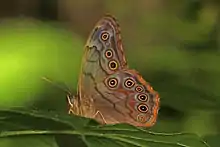Lethe creola
Lethe creola, the creole pearly-eye, is a species of brush-footed butterfly in the family Nymphalidae.[2][3][4] It is found it the United States from North Carolina and central Georgia west to eastern Oklahoma and eastern Texas.[5] Some authorities include this species in the genus Enodia as Enodia creola.[6]
| Lethe creola | |
|---|---|
 | |
| Scientific classification | |
| Kingdom: | Animalia |
| Phylum: | Arthropoda |
| Class: | Insecta |
| Order: | Lepidoptera |
| Family: | Nymphalidae |
| Genus: | Lethe |
| Species: | L. creola |
| Binomial name | |
| Lethe creola (Skinner, 1897) | |
| Synonyms | |
| |
The wingspan is 59–70 mm. Males have spotted forewings. The upperside is brown with patches of dark scales along the veins. The underside is tan for both males and females. Adults feed on sap, rotting fruit, carrion and dung.
The larvae feed on the leaves of Arundinaria tecta. They only feed at night and hide at the base of the host plant during the day. The species overwinters in the larval stage.
The MONA or Hodges number for Lethe creola is 4568.2.[7]
References
- "NatureServe Explorer 2.0 Lethe creola Creole Pearly-Eye". explorer.natureserve.org. Retrieved 1 October 2020.
- "Lethe creola Report". Integrated Taxonomic Information System. Retrieved 2018-04-12.
- "Lethe creola". GBIF. Retrieved 2018-04-12.
- "Lethe creola Species Information". BugGuide.net. Retrieved 2018-04-12.
- Butterflies and Moths of North America
- Calhoun, John V.; Leary, Patrick R.; Berthet, Bill; Warren, Andrew D. (2015). "Discovered at last: Lethe creola (Nymphalidae: Satyridae) is a resident of Florida". Southern Lepidopterists' News. 37 (2): 81.
- "North American Moth Photographers Group, Lethe creola". Retrieved 2018-04-12.
Further reading
- Pohl, Greg; Patterson, Bob; Pelham, Jonathan (2016). Annotated taxonomic checklist of the Lepidoptera of North America, North of Mexico (Report). doi:10.13140/RG.2.1.2186.3287.
